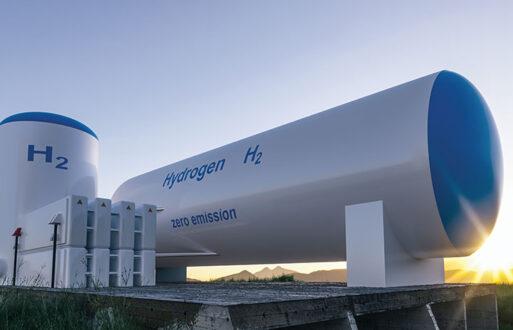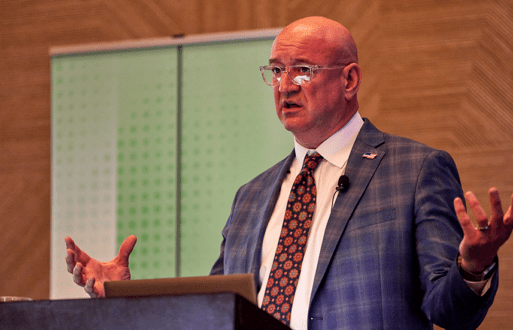The 2020s will be a decisive decade in the global effort to decarbonize our energy and climate systems. Our ability to integrate a full stack of new technologies into legacy infrastructure, operating systems, and markets is key to our collective success.
Functioning as a molecule or an electron, the hydrogen vector provides system integration and design capabilities to accelerate the viable commercial use of various hydrogen technologies and applications in upstream, midstream, and downstream operations. This versatility is evident in the projects included in this blog post. Each has a unique approach to the recalibration of carbon and capital flows based on the client’s asset base and investment strategy. PCI is expanding its optimization software systems to help companies extract the maximum value from their investments by managing and optimizing hydrogen and power assets as an interconnected portfolio.
This blog post features three diverse projects planned by current PCI clients and introduces a follow-up post that will focus on how PCI’s existing programs and platform can facilitate and accelerate the commercialization of hydrogen as a critical component of the new energy economy.
Sector Coupling via the Hydrogen Molecule
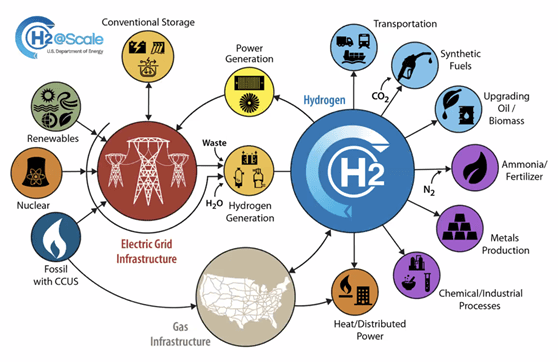
CCUS: Carbon Capture, Utilization, and Storage
The projects featured in this blog post indicate that the hydrogen vector has become a preferred option for sector coupling and currently attracts increasing R&D funding, policy support, and corporate investment. In addition, hydrogen’s integrative profile offers the ability to design projects with unprecedented levels of sectoral interconnectedness, as shown above in the figure from the U.S. Department of Energy’s H2@Scale initiative.
H2 and the Bipartisan Infrastructure Framework
The Bipartisan Infrastructure Framework (BIF), aka the Infrastructure Investment and Jobs Act, was enacted on Nov. 15, 2021. It appropriated $9.5 billion for clean hydrogen research, development, and demonstration programs managed by the U.S. Department of Energy (DOE). Of that amount, $8 billion is authorized to the Office of Clean Energy Demonstrations to develop four regional clean hydrogen hubs in different regions across the U.S. with the goal of company-led pilot projects with diverse project profiles and end-use applications. The funding will concentrate on hydrogen-based power systems and include “clean hydrogen” produced from nuclear, renewables, and fossil fuels with carbon capture, utilization, and sequestration.
The DOE will solicit proposals for clean hydrogen hubs by May 15, 2022, and select four regional hubs by May 2023, with $8 billion appropriated for fiscal years 2022-2026. The DOE Secretary of Energy will carry out the program, and the hubs will demonstrate the production, processing, delivery, storage, and end-use of clean hydrogen. The four hubs must demonstrate feedstock diversity with a preference for at least two of the hubs to be located within natural gas-producing regions. The BIF also provides $1 billion, which requires the DOE to establish a program to reduce the cost of clean hydrogen to less than $2 per kilogram by 2026. PCI is actively researching its capacity to play a significant supporting role in this process through advanced digital architectures designed for adaptive planning, operational resilience, and growth in new technologies and markets.
The following projects include current PCI clients and show hydrogen technologies and applications’ scope, scale, and operational sophistication. As the descriptions indicate, the hydrogen molecule’s integrative properties and energy content make it ideal for coupling existing and new infrastructure. In addition, these new system configurations offer dynamic supply and demand revenue models built for Environmental, Social & Governance (ESG) objectives designed for diverse positive outcomes and high-impact investments.
Entergy: Orange County Advanced Power Station
Entergy Texas will seek approval for a hydrogen and natural gas-fired combined cycle gas turbine (CCGT) power facility that will function as a large-scale distributed generation model. The Orange County Advanced Power Station is a 1,215MW dual-fuel combined cycle power facility. The plant will be located near Bridge City, Texas, and will power more than 230,000 homes and use a combination of natural gas and hydrogen.
If built, it could provide more than $1.5 billion in net benefits to customers by reducing reliance on energy markets through localized reliability. New local generation can protect customers from the potential risks of volatile prices in both the capacity and energy markets. Orange County is designed to be the most sophisticated dispatchable generator in the market. It will sell to the Midcontinent Independent System Operator (MISO) at a higher price than it costs to produce. The margins from these sales will flow directly to customers to offset their fuel charges. Its high-efficiency generator will also lower the price of energy purchased from MISO, providing customers savings through the gains made from selling into and purchasing from the market.
Entergy has created an alliance with power generation and equipment manufacturer Mitsubishi Power to develop hydrogen-capable CCGT facilities and related infrastructure to enable hydrogen production, storage, and transportation. Mitsubishi’s current J-series model can combust 30% hydrogen by volume with a development target of 100% by 2025. Mitsubishi Power Americas is a corporate powerhouse in developing the global hydrogen economy and can play a leading role in the buildout of hydrogen hubs in the U.S., including many of PCI’s existing and future clients. The success of the Orange County pricing model will, in part, depend upon the actual performance of the dual-fuel turbines combined with sophisticated physical asset optimization and sales platforms and PCI plans to establish itself as a leading provider of these services.
As Entergy Texas explained to Power Magazine, “Investing in hydrogen capabilities now will allow the Orange County Advanced Power Station to use two fuels and more economically convert to 100% hydrogen in the future, as changing circumstances warrant. This benefit is consistent with the nationwide movement toward a low-carbon economy and recognizes the investment communities’ and customers’ evolving demand for sustainability projects.”
PNW Hydrogen-Arizona Public Service: Palo Verde Nuclear Generating Station
PNW Hydrogen, LLC, an affiliate company of Pinnacle West Capital Corp, will receive $12 million from the DOE Hydrogen and Fuel Cells Technology Office (HFTO) and $8 million from DOE’s Office of Nuclear Energy (NE) for a total award of $20 million. The project will produce clean hydrogen from nuclear power at the Palo Verde Nuclear Generating Station in Phoenix, Arizona. Six tons of stored hydrogen will be used to produce approximately 200MWh of electricity during times of high demand and may also be used to make chemicals and other fuels. The project will provide insights about integrating nuclear energy with hydrogen production technologies and inform future clean hydrogen production at scale.
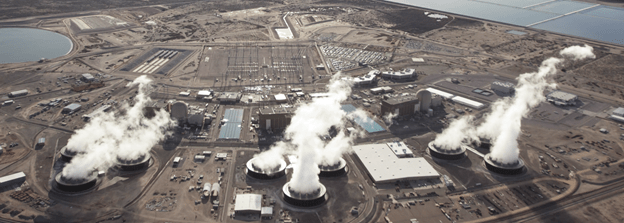
Courtesy: INL Media Relations, Palo Verde Generation Station
PNW Hydrogen LLC will be the primary recipient of the Palo Verde award and will collaborate with multiple stakeholders in research, academia, industry, and state-level government, including Idaho National Laboratory (INL), National Energy Technology Laboratory, National Renewable Energy Laboratory, OxEon, Electric Power Research Institute, Arizona State University, University of California Irvine, Siemens, Xcel Energy, Energy Harbor, and the LA Department of Water and Power.
This collaborative private-public partnership will use a Low-Temperature Electrolysis (LTE) system to produce clean hydrogen that would cut carbon emissions from two sources: traditional hydrogen production and burning natural gas for electricity. The hydrogen produced will then be used to help fuel a natural gas-fired plant owned by PNW’s electric subsidiary, Arizona Public Service (APS). A similar project is underway at Energy Harbor’s Davis-Besse Nuclear Power Station near Toledo, Ohio, including INL, Xcel Energy, and APS. The DOE-funded $10 million for this pilot project to demonstrate the technical feasibility and economic viability of large-scale commercialization using a hybrid hydrogen production system that uses Low-Temperature Electrolysis (LTE) using Polymer Electrolyte Membrane (PEM) technology to produce 100% carbon-free hydrogen.
“Developing and deploying clean hydrogen can be a crucial part of the path to achieving a net-zero carbon future and combating climate change,” Deputy Secretary of Energy David Turk said in a Department of Energy news release as the APS award was announced. “Using nuclear power to create hydrogen energy is an illustration of DOE’s commitment to funding a full range of innovative pathways to create affordable, clean hydrogen, to meet DOE’s Hydrogen Shot goal, and to advance our transition to a carbon-free future.”
Woodside Energy – Oklahoma Gas & Electric: H2OK
Australia’s Woodside Energy, Ltd. is looking to expand its growing hydrogen portfolio into the U.S., with plans for up to a 550MW facility in Ardmore, Oklahoma. Woodside has secured a lease and option to purchase 94 acres of vacant land at the Westport Industrial Park to develop its proposed H2OK project. The initial phase of the H2OK proposal will see the construction of a 290MW facility, which will use electrolysis to produce up to 90 tons of liquid hydrogen per day. Woodside also noted that the site offers the capacity to expand the facility to 550 MW in the future to produce up to 180 tons per day of liquid hydrogen.
H2OK would be built in a highly prospective part of the U.S. market, close to national highways and the supply chain infrastructure of major companies that have signaled their interest in securing reliable, affordable, and lower-carbon energy. The location is in a strategic transport and supply chain corridor, which could demand the hydrogen it produces come from heavy-duty trucks, warehouse forklifts, heavy-duty equipment, ground handling equipment, and fuel cell microgrids for warehouses and data centers.
Woodside is also taking a proactive role in developing the U.S. and Australian hydrogen markets, entering an MOU with Hyzon Motors as a New York-based supplier of zero-emissions hydrogen fuel cell-powered commercial and heavy transport vehicles. Woodside and Hyzon intend to explore opportunities to work together on demand stimulation, supply and infrastructure solutions, and coordinated advocacy.
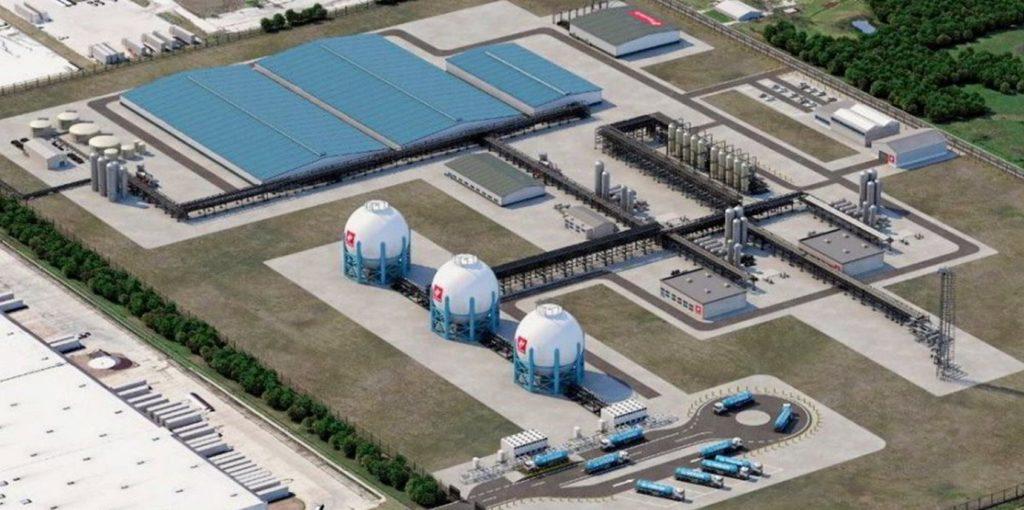
Artist’s impression: Woodside’s proposed H2OK hydrogen project in Oklahoma. Published with permission from Woodside Energy.
H2OK is intended to be a net-zero project, with the electrolyzers powered from Oklahoma’s existing network, which contains a large percentage of wind energy, and intends to use Renewable Energy Certificates (RECSs) to abate any remaining emissions. Woodside will continue to work with local power providers over the Front End Engineering Design (FEED) phase to understand power sourcing breakdown and emissions traceability in preparation for operations. The hydrogen production concept for H2OK has a lower carbon intensity than hydrogen produced from traditional SMR (steam methane reforming) processes. Woodside has engaged Oklahoma Gas & Electric (OG&E) through the site selection process, highlighting that the utility company has reduced emissions from operated power plants by 40% since 2005 and expects to lower emissions by 50% by 2030.
According to the Oklahoma Department of Commerce, Kenneth E. Wagner, Oklahoma Secretary of Energy & Environment, stated the following regarding Woodside’s project:
“The Woodside Hydrogen Project demonstrates Oklahoma’s continuous leadership as energy pioneers with the state’s constant search and devotion to new technologies and the development of new energy production like hydrogen, which lowers carbon emissions and makes the world a better place. Oklahoma’s formula for success is leveraging the state’s strong natural resources and human capital to create a diverse mix of fuel sources that work together to create the cleanest and most affordable energy in the United States. We are thrilled that Woodside has chosen to invest and partner with the State of Oklahoma on this important project.”
PCI Provides Early-Stage Intelligence for H2 Planning & Investments
Sophisticated buying, selling, and trading platforms are critical for optimizing the emerging hydrogen economy’s new carbon and capital flows. PCI brings 30 years of experience in power optimization software that services more than half of the power generated in North America and is used by 70% of the Fortune 500 energy and utility firms in the U.S. The hydrogen decade is perfectly timed for exponential innovation curves across the complete value chain, and PCI is uniquely positioned to integrate new assets into its platform. This integration can occur across a full suite of programs designed for operational models that improve system reliability, resilience and reduce carbon intensity.
We recently hosted an educational webinar, “Hydrogen Power: Opportunities & Challenges.” If you missed it, request the slides!
David B. Grantham is the founder of RedwoodAdaptive, an energy and environmental consultancy located in Norman, Oklahoma.



